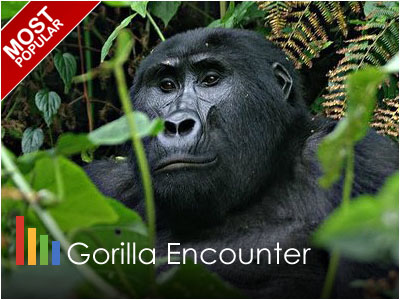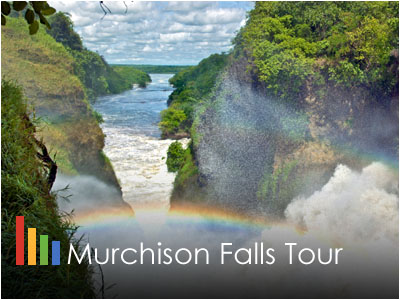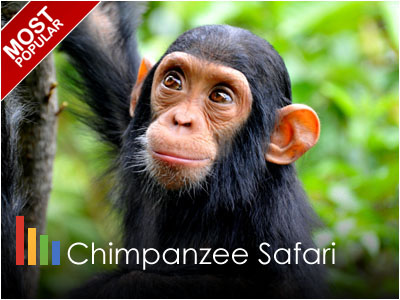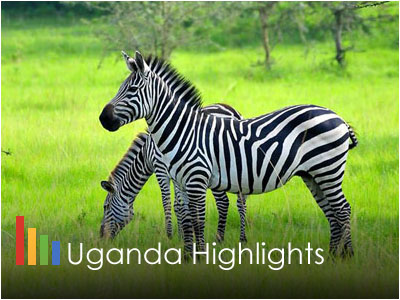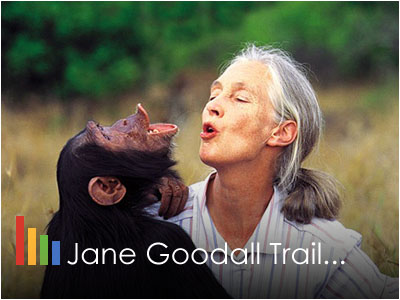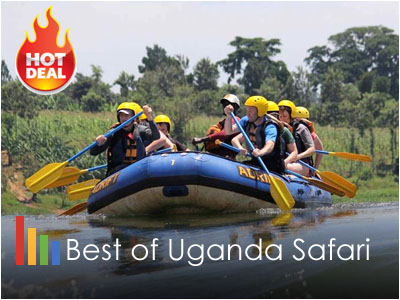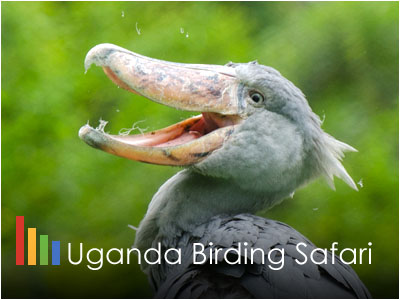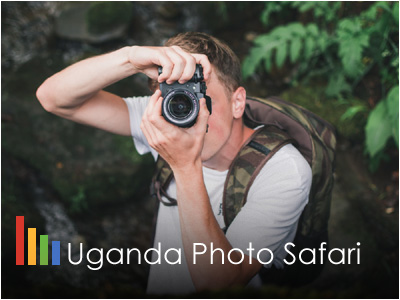Uganda Birding & Wildlife Safari - 14 Days
Uganda Bird-watching Safari: 14 Days
Uganda Birding Specialist Safari: On this tour you will experience the best of Uganda's wildlife including birding with a specialist bird guide as you try to put in a good count of the wide array of species in Uganda. You will also get to see the great primates, the mountain gorillas and chimps plus savanna game. This safari shall take you to Queen Elizabeth National Park and Lake Bunyonyi excellent places for bird watching with a specialized birding guide. There are over a 1,061 bird species, which makes Uganda a birder's paradise. Species include: Shoebill Stork, Saddle Billed Stork, Pelicans, Herons, African Fish Eagle, Bateleur, Long Crested Eagle, Vultures, Owls, Grey Crowned Crane, Great Blue Turaco, Rwenzori Turaco, Hornbills, Honey birds, Sunbirds, Weavers and the African Finfoot. Uganda famous birding sites featured in the itinerary include Lake Mburo National Park, Budongo Forest Reserve, Semliki Valley National Park and Murchison Falls National Park. Shoebill, Green-breasted Pitta and Red-faced Barbet are just some of the star birds likely to be encountered on this safari. It is an experience of a lifetime! More about Uganda.
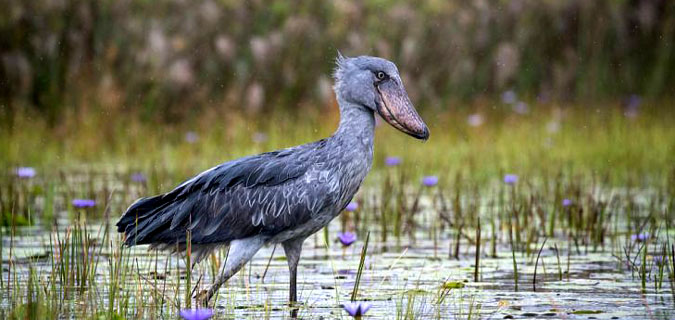
SAFARI ITINERARY: 14 Days / 13 Nights [Expand For Details]
The essential birds of Uganda are Shoebill, the 20-plus Albertine Rift endemics, and finally a few other birds tough to locate elsewhere, such as Green-breasted Pitta. Most other birds can be seen in other countries and are not focused on during this tour, although you’ll certainly see a lot of some widespread spectacular species such as Great Blue Turaco, Ross’s Turaco, amazing barbets, and so many others. Our 14-day tour allows one to find the most important birds and primates that Uganda has to offer. Shoebill is almost guaranteed. Over 20 Albertine (Western) Rift endemics are also sought, including one of Africa’s most fabulous turacos, Rwenzori Turaco, and of course the “must-see” Grauer’s (African Green) Broadbill.
Of late, Uganda has become the classic country for finding the Green-breasted Pitta otherwise very difficult bird to come across. We also look for other range-restricted birds, such as Red-faced Barbet that is also found in a remote part of Tanzania excluded from most birding tours to that country. Ross’s Turaco, Great Blue Turaco, and various other birds are virtually garden birds in Uganda, “the Pearl of Africa”. Other highlights of our Uganda birding tour are a great many primates such as Uganda Red Colobus, Guereza, Mountain Gorilla, and Chimpanzee, not to mention the spectacular scenery, including such famous places as Lake Victoria, Bwindi Impenetrable Forest National Park, and last but not least the Virunga Mountains. We cannot forget the warm and inviting cultures of Uganda People. This trip shows all these and more in 2 short weeks!
-
Day 1 - Entebbe, Uganda: Boma Hotel, Entebbe (LD)Open or Close
On arrival at Entebbe International Airport you will be met by a company representative and transferred you to your Hotel. But depending on your time of arrival we may go for optional birding in either the botanical gardens or the Uganda Wildlife Education centre which will give us a great overview of the more common and widespread species found in Uganda. This afternoon we tour Entebbe Botanical Gardens with chances of seeing the dazzling Black-headed Gonolek as well as the striking Double-toothed Barbet are both common around Entebbe. Bat Hawk and African Hobby are sometimes seen around town. Broad-billed Roller, Palm-nut Vulture, numerous weavers, and perhaps our first Great Blue Turaco might be seen at the Entebbe Botanical Garden on the edge of Africa’s largest lake - Lake Victoria. This evening we have a briefing session on the up-coming birding days. Dinner and overnight at Boma Hotel (LD).
-
Day 2 & 3 - Lake Mburo National Park: Mihingo Lodge (BLD)Open or Close
Bypassing the bustling city of Kampala (adjacent to the more pleasant small town of Entebbe) we head for Mabamba Swamp, one of Africa’s most accessible sites for the monstrous Shoebill. The papyrus-swamp-loving Red-chested Sunbird, numerous weaver species that build their impressively neat nests in the wetlands, coucals, and many tropical waterbirds such as Lesser Jacana abound as we do a dugout canoe trip into the huge swamp. Swamp Flycatcher is also common here. After seeing Shoebill we continue to our site for Orange Weaver, often seeing Eastern Plantain-eater, Ross’s Turaco, large flocks of the noisy Great Blue Turaco (the far-carrying calls of which are one of the characteristic sounds of Uganda), Grey Kestrel, and a very big, beautiful barbet, Double-toothed Barbet. We eventually arrive at Lake Mburo National Park (where we’ll spend two nights), which breaks the journey between Entebbe and the southwestern border region of Uganda, where we will look for over 20 Albertine Rift endemics (this, also known as the Western Rift, is a branch of the Great Rift Valley).
The following morning we take a boat trip on the lake, and this is one of the easiest places to find African Finfoot. We sometimes see overwintering Malagasy Pond Heron and Papyrus Gonolek in addition to an array of kingfishers including the likes of Malachite Kingfisher, Giant Kingfisher, Pied Kingfisher, and the rare Shining-blue Kingfisher. In general this park gives us an excellent opportunity to see a lot of arid-country birds, which can include Blue-naped Mousebird, Bare-faced Go-away-bird, Golden-breasted Bunting, and the incredibly localized, rather “thin-on-the-ground” Red-faced Barbet, along with a more widespread East African species, Spot-flanked Barbet. Nubian Woodpecker is often heard before it is seen. Like in most arid-habitat parks in East Africa a large bird list can be accumulated very fast, and the above species are just a few of the many goodies we expect to find. This is the only place where we’re likely to see Plains Zebra during our Uganda birding tour, and there are a lot of other mammals as well, such as Hippopotamus, African Buffalo, Defassa Waterbuck, Bohor Reedbuck, Topi, Common Eland. All meals and overnights at Mihingo Lodge (BLD).
-
Day 4 - Mgahinga & Virunga Mountains: Mount Gahinga Lodge (BLD)Open or Close
The Mountain Gorillas here freely roam into neighboring Rwanda and the DRC, but with extreme luck we might stumble across them (usually we have to wait until we get to Bwindi Impenetrable Forest National Park, though). One of the main reasons we include this park on our Uganda birding tour is to look for the gorgeous Rwenzori Turaco. This park has a lot of bamboo forest, in which we search for Abyssinian Ground Thrush. The nearly extinct Shelley’s Crimsonwing is always possible – this Vulnerable (IUCN) species seems to be declining, and for once not because of humans. We may get a head start with some other Albertine Rift endemics, but most of these will have to wait for Bwindi. Meals and overnight at Mount Gahinga Lodge (BLD)
-
Day 5 & 6 - Upper Bwindi Forest (Ruhija) : Ruhija Safari Lodge (BLD)Open or Close
We travel to one of Africa’s richest forests for primates and birds, starting in the high-altitude Ruhija part of the national park. We’ll start birding the forest-covered hills as soon as we arrive, looking for the beautiful Black Bee-eater and also trying to find Grauer’s Swamp Warbler at a roadside site, so that we can reduce the length of the long walk on day 6, this warbler occurring right in the lower reaches of Mubwindi Swamp. Mountain Yellow Warbler might also be seen, nice to compare with Papyrus Yellow Warbler, for which we try another day. A walk most of the way down to this swamp can’t be avoided, though, as Grauer’s (African Breen) Broadbill, one of Africa’s most desirable birds, also occurs there. The good-looking, highly localized Yellow-eyed Black Flycatcher also lurks pretty close to the bottom reaches. The walk down to the site for this broadbill (and back) takes a large part of the day, but this is one of the best birding days of the entire tour.
Trip participants usually end up getting a constant stream of life-birds throughout the day, mainly Albertine Rift endemics. Banded Prinia, Mountain Masked Apalis, Rwenzori Apalis, Chestnut-throated Apalis, the strange-looking (and dull for a barbet) Grey-throated Barbet, Red-faced Woodland Warbler, and up to four species of quiet, brightly colored forest finches known as crimsonwings (all of them very difficult, though!) are often encountered. There are too many high-quality species to list here, but we hope to find Olive-breasted Greenbul (one of the more attractively colored greenbuls – we’ll see a great many of the duller ones, as Uganda is absolutely full of them, presenting quite an identification challenge). We do need to mention a couple of the other range-restricted species as well, though – the very long-tailed Blue-headed Sunbird, the dazzling Regal Sunbird, Stripe-breasted Tit, Rwenzori Batis, and also slightly more widespread species like the fabulous Bar-tailed Trogon and Rwenzori Hill Babbler. Ruhija Safari Lodge (FB)
-
Day 7 & 8 - Lower Bwindi Forest (Buhoma): Buhoma Safari Lodge (BLD)Open or Close
En route between the higher-altitude Ruhija and the lower-elevation Buhoma sections of the park we stop to bird “The Neck”, which allows us to see quite a number of species we won’t find elsewhere. Black Bee-eater and Cinnamon-chested Bee-eater are both quite easy to see here. Chubb’s Cisticola duets from the thickets. Black-and-white Shrike-flycatcher (also known as Vanga Flycatcher) might be seen – this charismatic bird usually moves around (a lot, it’s an extremely lively species) and makes lots of noise as it flies around from one perch to the next. It has a fabulous crest, but the female is chestnut-and-white, whereas the male is black-and-white with striking yellow eyes. We might also see Brown-throated Wattle-eye, Mackinnon’s Shrike, Bronzy Sunbird and several other sunbirds, African Grey Woodpecker, Augur Buzzard, etc.
At Buhoma itself there is the opportunity for one day optionally trekking for Mountain Gorilla (this is a strenuous, activity; if you decide not to join you’ll be taken birding instead, or you can relax or look at and photograph birds around the lodge). Deep-forest birds we’ll seek include many more localized endemics that barely get into neighboring countries – Grauer’s Warbler (not to be confused with Grauer’s Swamp Warbler, which we should have already seen), Petit’s Cuckooshrike, Lühder’s Bushshrike, Brown-capped Weaver and other weavers of the forest canopy, Red-throated Alethe, and lots of others. We’ll be sure to spend time looking for slightly more widespread birds as well, including the skulking White-spotted Flufftail, Red-shouldered Cuckooshrike, Olive-bellied Sunbird, some beautiful forest barbets such as the large Yellow-billed Barbet, the dazzlingly bright and shiny, green-and-yellow African Emerald Cuckoo, and, last but not least, Black-billed Turaco. Buhoma Safari Lodge (FB)
-
Day 9 - Queen Elizabeth National Park: Ihamba Safari Lodge (BLD)Open or Close
We stop over in Queen Elizabeth National Park (often staying on the Mweya peninsula itself, along the Kazinga Channel) en route to Kibale Forest. England’s queen officially opened this national park (well-known for its tree-climbing lions and boasting 100 mammal species and 600 bird species!) in 1954. One of the highlights of our stay here is getting out onto the Kazinga Channel by boat and seeing Nile Crocodile, Hippopotamus, and a great many waterbirds. Naturally we also see Common Warthog, African Buffalo, Uganda Kob and a plethora of other mammals. Forest Hog usually steals the show, however. Dinner and Overnight at Ihamba Safari Lodge (FB).
-
Day 10 & 11 - Kibale National Park : Kibale Forest Camp (BLD)Open or Close
The drive from Queen Elizabeth to another fantastic national park, Kibale, is amazing: We traverse the foothills of the “Mountains of the Moon” (the Ruwenzori Range) and cross the equator, eventually arriving at the richest forest for primates on the African continent. Our main avian target is Green-breasted Pitta, which is best found at dawn, when its display call allows us to narrow down its whereabouts (otherwise, despite the jewel-like colors of this bird, it’s like looking for a needle in a haystack on the forest floor). While we search for this bird the atmospheric, quite scary noises of large troops of Chimpanzees resonate through the forest.
There is also the opportunity for optionally trekking for Chimpanzees. We should also find some other primates such as L’Hoest’s Monkey, Uganda Red Colobus, one of the most striking of all African primates, Guereza (Eastern Black-and-white Colobus), Red-tailed Monkey, Grey-cheeked Mangabey, and other monkeys (not to mention the well-built Olive Baboon, which wanders around in massive groups, usually on the ground). We also have a lot of good birds to see, which might include White-headed Wood Hoopoe, Narrow-tailed Starling, Black-billed Turaco, and Chestnut Wattle-eye. Dinner and Overnight at KIbale Forest Camp (FB)
-
Day 12 & 13 - Murchison Falls National Park : Sambiya River Lodge (BLD)Open or Close
Depart after breakfast to Murchison Falls National Park. Brief stop in Bodongo Forest in search of Chestnut-capped Flycatcher is a star bird – along with two other species: there is a trio of small warbler-like flycatchers that are taxonomically enigmatic, and this is one of them (we usually find the other two on our Tanzania and Mozambique birding tours). Fraser’s Forest Flycatcher is another prized bird here. But it’s the kingfishers (most of them not associated with water!) that make the Royal Mile famous. Chocolate-backed Kingfisher is probably the most popular of them all, but then Blue-breasted Kingfisher, African Dwarf Kingfisher, and others are also completely dazzling. Red-tailed Ant Thrush, Fire-crested Alethe, and Nahan’s Partridge usually stay close to the forest floor. The pretty Rufous-crowned Eremomela, White-thighed Hornbill, and a lot of others inhabit the canopy.
Some fantastic forest barbets, tinkerbirds, and woodpeckers abound. There are a great many greenbuls, different species inhabiting different levels of the forest from the undergrowth to the canopy, and these are fun (or, in some people’s opinions, not!) to learn to identify. Later check in to our lodge in Murchison Falls for an evening reest. In Murchison Falls National Park, we do boat trips and birding/game drives in this area, where we always add a great many new birds to our list. This is also a brilliant place for big and small mammals that might include Lion, Leopard, Rothschild’s Giraffe, Oribi, Lelwel Hartebeest, Common Warthog, the scarce Patas Monkey, and many others. Black-headed Lapwing, Silverbird, Speckle-fronted Weaver, Abyssinian Ground Hornbill, Red-throated Bee-eater, Swallow-tailed Bee-eater, Rock Pratincole, White-headed Barbet, Black-billed Barbet, Meyer’s Parrot, and Bateleur are just a few of the species on our rather large menu.
We should of course mention the fact that the massive volume of the Nile River is forced through a narrow gap here at Murchison Falls – while looking at this site there is a small chance that we might also manage to find Pel’s Fishing Owl or Bat Hawk. Where possible we can arrange night drives for some nightjar and owl species in the area; these may include Long-tailed, Plain, and Pennant-winged Nightjars and possibly Greyish Eagle-Owl. All meals and overnights at Sambiya River Lodge (BLD)
-
Day 14 - Transfer to Entebbe + Departure: End of TourOpen or Close
Have a relaxed breakfast with spectacular view of the beautiful sorroundings around the hotel. We’ll look for any species we might still be missing as we make our way back to Entebbe. After lunch in Kampala at the end of this exciting trip, you are transferred to Entebbe International Airport in time for you to check-in for your onward flight. Hotel rooms not included but are available on request (BL).
TOUR RATES : 2025/2026 - [See Exchange Rates Here]
-
High Season 02 Jan - 31st Mar / 1st July - 31st OctOpen or Close
· Per Person / Adult Sharing: US$ 9,620
· Single Room Supplement: US$ 1,785
· Discounted Group Rates: Available on Request
-
Shoulder Season 1st Nov - 15 DecOpen or Close
· Per Person / Adult Sharing: US$ 8,725
· Single Room Supplement: US$ 1,450
· Discounted Group Rates: Available on Request
-
Low Season 1st Apr - 30th JuneOpen or Close
· Per Person / Adult Sharing: US$ 7,895
· Single Room Supplement: US$ 1,295
· Discounted Group Rates: Available on Request
-
Supplements & SurchargesOpen or Close
SINGLE ROOM SUPPLEMENTS: Generally, group tours are priced based on a standard room charge that’s divided between two people sharing a twin or double room. If a solo traveller chooses to have their own room, they are not sharing the cost with a second traveller. The single supplement is therefore an additional charge to make up the full cost of the room. Most hotels in East and Southern Africa will charge you an extra fee for staying in a room alone! Sic! This is why, against our wish, we charge you the 'Single Room Supplement' for travelling / staying solo on your trip.
HOLIDAY / EASTER / CHRISTMAS: In addition, most hotels in East and Southern Africa charge Easter and Christmas Supplement from if your booking falls on between December 24th and Jaunuary 2nd of every year. Most Safari Lodges charge the supplement for the following dates 24, 25, 26 and 31 December and 01 January every year. The best way to avoid the supplements is to avoid travelling on dates within the mentioned dates (if possible) not only to avoid the high rates but also to avoid the huge crowds of people withnessed in the festive season travel.
INCLUDED / EXCLUDED in the price. [Expand For Details]
-
+ Included in the Tour PriceOpen or Close
These items form the basic components of your tour / safari cost and MAY NOT be excluded / removed from the tour pacakge all-together. However, if you still like the tour without some of of the basic components, kindly request for customization of the tour. The tour cost includes;
· Free pick-up / drop-off from your Hotel / Kampala / Entebbe Airport
· Accommodation in Entebbe / Kampala before the tour
· All transportation in a custom-built safari vehicle with window seat guarantee
· 3 meals a day / Full-Board accommodation whilst on Safari Hotels, lodges or Camps
· All parks and game reserve entry gate fees including vehicle & driver fees
· Boat launch to the bottom of the powerful Murchison Falls
· Gorilla Tracking Permits from Uganda Widlife Authority
· Services of an English - speaking and professional birding safari driver/guide
· Unlimited Supply of Complimentary Bottled Drinking Water on safari
· All packed lunches as outlined in the itinerary
· Guaranteed Departures with a minimum of just 2 travellers!
· ALL Government taxes and levies
-
+ Excluded in the Tour PriceOpen or Close
These items are excluded from your tour cost / package. You are therefore expected to make own arrangement for some such as your International Flight Tickets, Travel Insurance and so on. Others are available as 'add-ons' to your tour and we shall be glad to include any extras you like at a reasonable cost. The tour cost excludes;
· International Air Fares to and from Africa
· Travel Insurance Cover, Personal or Baggage (Highly Recommended)
· Cost of Tourist or Business Visa and any other associated expenses
· Optional excursions not mentioned in the inclusions and/or quoted separately
· Expenses of personal nature such as phone calls, internet, laundry etc
· All soft and hard drinks (alcoholic drinks, wines and spirits)
· Tips and gratuities to driver guides/lodge/hotel staff
· Festive days supplements such as those on Easter and Xmas dates
· All other extras not mentioned in the 'included'
-
+ Our Value-Added Features The 'AfriChoice Difference'Open or Close
When you book a tour with us, we want always want you to fee special. That is why we go the extra mile not only to make you smile but to ensure that your are taking home only the fondest of memories from our trips. Below are some of the special treatments you are unlikely to find with other tour operators;
· Special 'Welcome Package' for you upon arrival
· Assorted wildlife and birds guide books and reference materials
· Free upgrade to a 4x4 Safari Vehicle with UNLIMITED game drives on safari
· Free supply of UNLIMITED bottled mineral water whilst on safari
· Complimentary 'AfriChoice!® Authentic African Safari Sun Hat
· Free Membership to AMREF's Flying Doctors Emergency Evacuation Programme*
· Signed & Sealed 'Participation Certificate' (Gorilla Experience*)
· Special 'Farewell Dinner' at the end of your trip (Time Permitting*)
· All-year-round departures with a minimum of 2 travelers
-
+ Important Tour NotesOpen or Close
CAUTION: This trip is moderate in terms of fitness required, except for some days that are considered quite strenuous, such as the day of gorilla trekking and the day hike into Mubwindi Swamp and back. Chimpanzee trekking and looking for Green-breasted Pitta can also involve quite a lot of walking. You are welcome to opt out of any activities if you don’t feel you’ll manage them. There are also many days of forest birding; please wear appropriate clothing items (dark/neutral clothing and caps instead of very wide-brimmed hats) and be ready to spend good amounts of time on foot with a good chance of soaking rain, so protection for camera gear is advised.
IMPORTANT Tour Booking Information
Your international airfare to and from Africa is NOT INCLUDED in the safari programme cost, UNLESS it is clearly stated otherwise. You are responsible for making your own flight / air fare arrangement to and from Africa. While booking your flights, kindly pay attention to the safari program start / end dates and venue to avoid missing departures of incurring extra costs on connection flights in Africa. Please feel free to Contact Us should you require any assistance with your flights to and from Africa.
At AfriChoice, flexibility is our specialization and so we can customize above or any tour according to your taste, budget and schedule. Any element can be changed including the activities, length, hotels and destinations can be adjusted as you like subject to availability of the affected services. Our experienced safari consultants will be glad to assist you. To get more information on how you can customize this tour, please DO NOT hesitate to Contact Us .
Please 'Click here to read Privacy Policy'. Protecting your privacy is our top priority.
Call or Write To Us for more information:
Other Popular UGANDA Safaris
-
Gorilla Tracking Safari
Bwindi Gorilla Safari 3 Days
-
Murchison Falls Safari
Murchison Falls Safari Tour
-
Uganda Chimpanzee Safari
Uganda Chimpanzee Watching Safari
-
Uganda Highlights Safari
Uganda Birds, Gorillas & Big Game Safari
-
Jane Goodall Safari Trail
Jane Goodall Chimpanzee Safari
-
Best of Uganda Safari
Uganda Wildlife & Adventure Tour
-
Uganda Birding Safari
Uganda Wildlife & Bird-watching Tour
-
Uganda Photography Safari
Uganda Gorilla & Wildlife Safari



 Paul Kitching - UK
Paul Kitching - UK Karen Howard - CANADA
Karen Howard - CANADA



